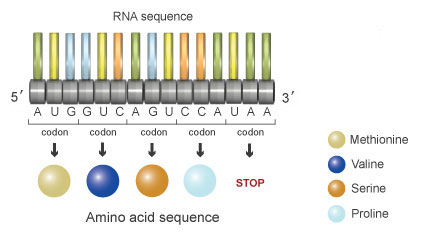What type of mutation will not affect the protein produced?
1 Answer
If there is no change in translated protein after appearance of a mutation in the corresponding gene, then that is called Same-Sense mutation.
Explanation:
Mutation takes place in genetic DNA. A transfer of genetic message takes place by transcription of RNA. We may say that recipe of a protein is written on double stranded DNA, which is copied on single stranded RNA and taken to ribosomes for protein synthesis. So any change in DNA base pair (mutation) would be truly copied by RNA which may lead to formation of abnormal protein.
Protein is primarily formed of a series of amino acids: often called a polypeptide . 20 amino acids are used by living cells to generate protein. A protein may have a series of only 9 amino acids (e.g. oxytocin) or could be 374 amino acids long (e.g. G-actin). Particular sequence of amino acids in a protein is specifically coded by DNA as well as RNA.
Consecutive three bases on RNA form a genetic word: called a triplet codon ; it represents an amino acid. Thus sequence of bases on RNA could be seen as sequence of triplet codons , written in comma-less manner.
[Four bases of RNA form 64 three-lettered 'words' by different combination of three letters; 61 of these triplets represent 20 amino acids-- thus more than one codon could be available for one amino acid . Rest 3 'words'-- UAA, UAG, UGA, do not represent an amino acid; they are called nonsense codons.]

(When RNA dictates protein synthesis on the surface of ribosomes, amino acids are attached as per the sequence of codons written on RNA. When a nonsense codon is encountered by ribosome, protein synthesis stops because there is no corresponding amino acid which could be attached to the growing polypeptide chain. )
Mutation is any change in DNA base pair, which when copied on RNA may change the 'letters' in a codon. Even mutation of a single base pair may change meaning of codon on RNA.

Despite change in sequence of letters in RNA, a codon could represent same amino acid (because there are more than one codon for each cmino acid). This is called same-sense mutation. Such mutations are phenotypically silent .

